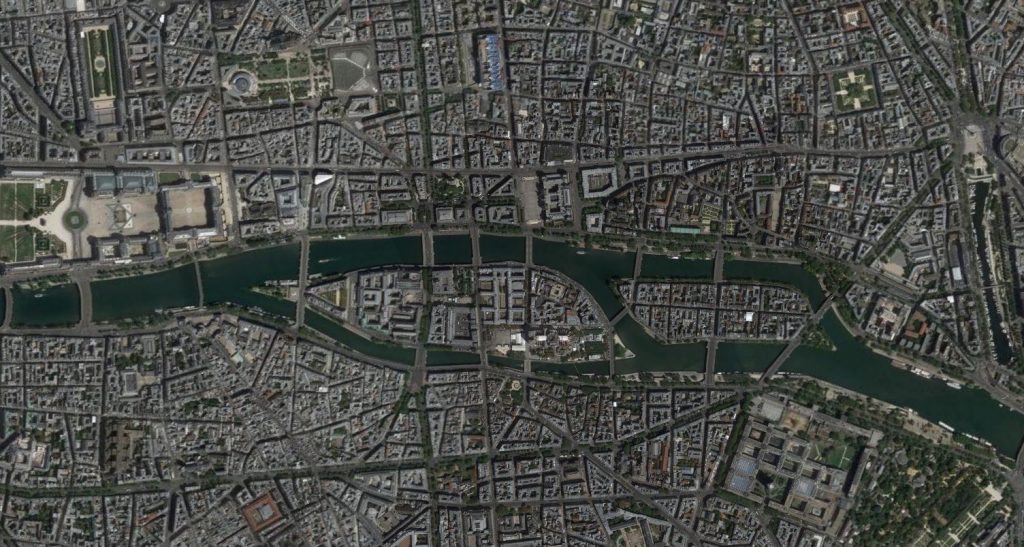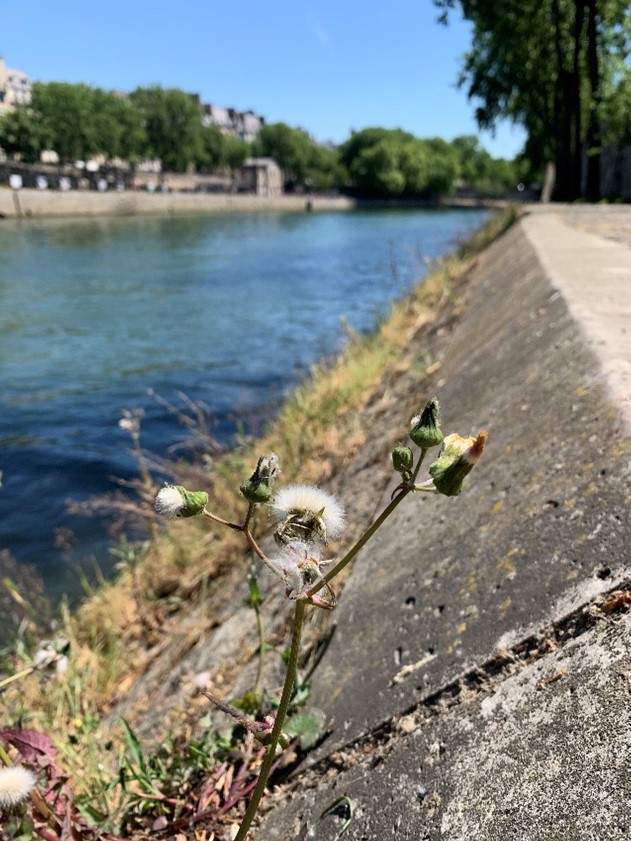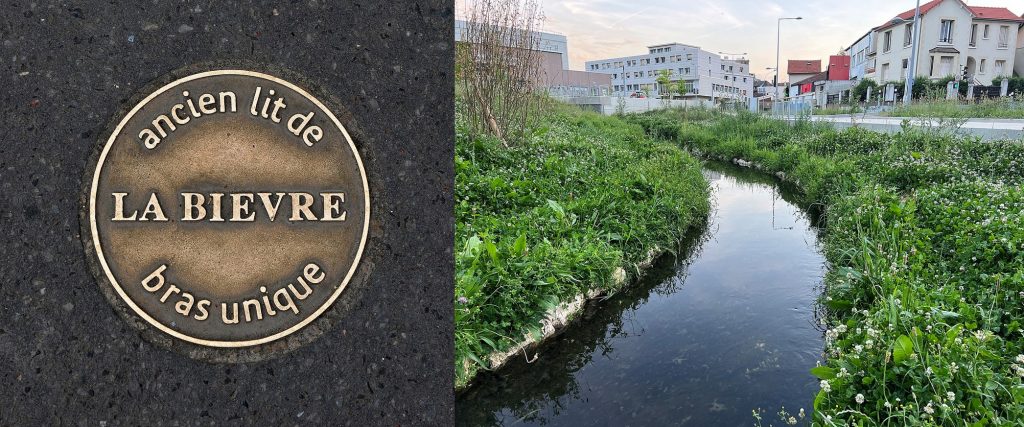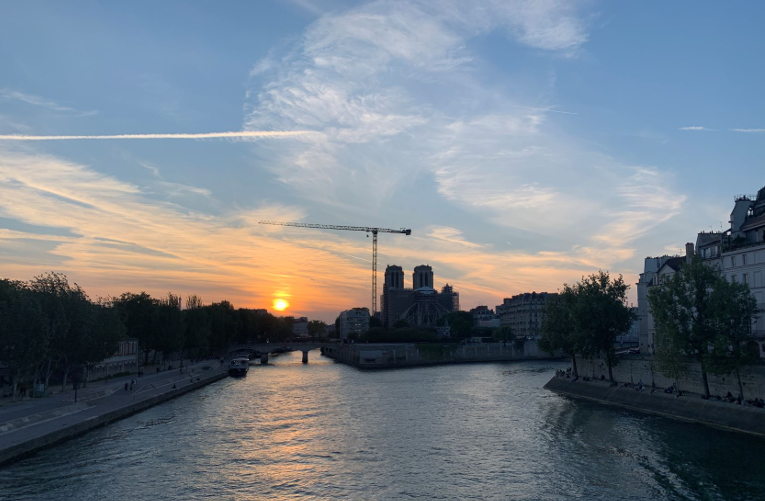Reflecting on a River
As I curl up on the couch drinking in the sounds of a Missouri thunderstorm, I’m thinking of the rivers in my life. Outside, the rain collects in the gutters and streets before being shed into an artificial ecosystem of concrete culverts, water retention basins, and channels. This infrastructure sits in the watershed of South Creek, the nearest urban stream in my neighborhood and one of the most hopeful places I know. South Creek is one of the most nature-rich areas in my city, a place of restoration, regeneration, and if not wilderness then certainly wildness.
The creek is seven years into its stream restoration project and now has banks densely vegetated with grasses, flowers, reeds, and shrubs. Over a hundred trees were planted along this restored stretch of urban stream. What used to be a concrete channel echoing the notorious Los Angeles River is now an urban oasis with a path winding along it. For those of us seeking reconciliation between the natural world and this human world we’ve built for ourselves, this place offers a vision for what the future can look like. As I collect stories of rewilding that give me hope, the story of South Creek is one of my favorites, but it’s far from the only one.
There is a new urban paradigm germinating among cultures all over Earth, where the connections between human and Gaia are slowly growing. If the past few hundred years saw an attempted divorce of ourselves from the natural world, except where the mines took and the smokestacks gave back, then this perspective sees a great remarriage, a restoration of our biological bond to Earth, a rewilding. South Creek is my closest example of this, but as my study abroad this past spring took me to Paris I got a front-row seat to a new urban river restoration, where a metropolis is actively healing the water it depends on.
The Seine River is the heart of Paris. As a student with extremely good fortune in apartment placement, I was lucky enough to stay on the Île Saint-Louis, the heart of the heart. That’s the smaller of the two islands in the middle of the Seine. The larger Île de la Cité with iconic Notre Dame was just across a bridge. Living here was a front-row seat where I could observe the relationship Parisians have with the natural world, and how that relationship is reflected in the recovery of the Seine.
In Paris she flows supreme: loved and loved to death. It’s been a hundred years since swimming here was made illegal, and while the banks attract throngs, access to the water is cut off. My favorite part of the Seine’s story, though, is how she’s resurrecting. Decades-old visions are playing out, and Paris is making the Seine swimmable again. In my time there as I toured cathedrals and infamous landmarks I would also come to know this river and her story, a hopeful one about Paris’s reconnection with her river.

The two islands in the Seine, the larger Île de la Cité and smaller Île Saint-Louis (Image from Google Earth)
The Story of the Seine
The relationship is a complicated one that goes back thousands of years and has been improving in the last few decades. Intense urban activity has seen the Seine constrained with walled, inaccessible banks and, as with so many riverside cities, seen it turned into a citywide drain. The river as living entity has long been replaced by the river as infrastructure; it’s not an ecosystem, it’s a boat highway. In the middle of Paris, the Seine is an artificial thing, something created by and for Parisians. Still, around the parks I visited there were beautiful signs promising a variety of wildlife one could expect to see. Fish, birds, reptiles, amphibians, insects, and plants are not just found in the vicinity, they’re part of the Seine’s living ecosystem. The Seine is still alive, and slowly recovering.

Végétation de résistance: A snapshot of the resistance vegetation that clings to the side of the Seine. Incidentally this is also the location of my first dip in the Seine following a series of unfortunate events involving a phone, a thief and a bankside wrestling match. (Image by Jeremiah Jones)
There’s an impressive number of species in the river, demonstrating past improvements made since the Seine was declared biologically dead in the 1960s. By 1990—when Paris hosted the Olympics for its first time, there was enough concern that then-Mayor of Paris, Jacques Chirac, promised to make the Seine swimmable in three years. To prove his leadership, he promised to be the first back in the water. After those three years improvements had been made in pollution reduction, but they didn’t come fast enough for that promised swim to happen. The reason behind his promise was historic though. Just 23 years after the first Olympics, swimming had been outlawed in the Seine—the public health threat being too great. Since then, however, helped by certain promises over the years that spotlighted the issue, the health of the river has greatly improved. In 2024 the Summer Olympics are coming to Paris, and the plan is to hold the swimming competitions in the Seine. When the Olympics are over, riverside swimming pools will open to the public. After a hundred years, Parisians will once again be able to wade in the waters of the Seine.
Now to get it to complete swimmability, a big part of the plan is to stop the majority of polluted stormwater from entering the river via an underground tank. During periods of high rainfall, Paris’s combined sewer system leads to 44 storm flows ready to dump rainwater and raw sewage into the Seine if the sewer system is overwhelmed. To this end a huge storage tank is being built underneath Square Marie-Curie on the left bank. It can hold 12 million gallons of stormwater (think 30 Olympic-sized swimming pools), which will be stored until the rain ends before being sent back into the sewer system for treatment.
Thinking Like a River
For 1.6 billion dollars this centerpiece to a swimmable Seine has a lot resting on it, but this highly technical infrastructure project can’t clean the city alone. To avoid using this investment as a Band-Aid, Paris should move beyond damage control and proactively look to the Seine’s full watershed. Paris should become a sponge city, where green infrastructure and rewilded ecosystems reconcile with the urban fabric.
Every square meter that isn’t some sort of (hopefully permeable) pavement could be part of a hydrological system that stores water in vegetation, green roofs, rain gardens and reconstructed wetlands. Bankside parks aren’t rare in Paris. How easy it would be to turn them into natural filters for the Seine, like park-sized kidneys filtering Paris’s runoff. With upfront effort and space set aside, Paris could let portions of itself rewild, from ditches to rooftops, connecting natural spaces into a system of natural ecosystems and biodiverse wildlife. Rewilding will take dedication and money. Restoring takes effort. Healing requires more than harm does. Paris, however, is in a perfect position to accelerate and lead rewilding.
The heart of the Seine inside Paris, where it flows past the two islands of Ile Saint-Louis and Île de la Cité, is a UNESCO world heritage site. Those drop-offs and steep ramps are part of a constructed riverscape that has international acclaim. I don’t see a deconstructed riverbank full of plants, swimmers and kayakers happening here, but it doesn’t have to look like such. Here a guided rewilding could look like floating gardens and reed beds, absorbing bacteria before it goes downriver to the future swimming areas. While some locations may require a spatial reckoning between boat docks and gardens, walls don’t have to be blown away to rewild. Environmental restoration happening in the in-between spaces, the lost patches of ignored ground and water, can help bring Paris to leadership in reconciliation with nature.

An Evening on the Canal Saint-Martin: Standing on the Passerelle de Mornay footbridge and looking toward the Place de la Bastille, what opportunities can we see for riverside rewilding? (Image by Jeremiah Jones)
Burial (and Resurrection) of the Bièvre
There are other places in the city begging to be restored and linked together in an ecosystem of parks and gardens. Chief among them is the Bièvre, a long-forgotten little sibling to the Seine. As second river and tributary to the Seine, the story here is a sad familiar tale of a river too useful to live, where everyone rushed to its banks to remove water and return dyes, chemicals, and toxins. Beavers, one of the probable namesakes of the stream, would be impossible to see today: the river was so abused that authorities had it paved over from 1860 to 1912. After enclosure its waters were diverted to the sewer system, and today golden plaques mark its old path. During my time there I walked right over the plaques in Square René Le Gall, standing on the ghost of the river. Upstream though, just outside of Paris, the Bièvre is being unburied and given room to meander again.
For the restoration, there is no ‘back” to go to. For almost a thousand years its banks have been modified and slowly ecosystem-engineered to death. Waves of dams and mills and factories eventually turned it into an open sewer and condemned it to burial. However, like the neighboring towns of Gentilly and Arcueil that are already uncovering the Bièvre river upstream, Paris can move to a new version of its streams and rivers that give them room to come alive again. Paris can be an urban environment that relaxes its death grip on nature and gives it space while incorporating it into the built environment. The Bièvre and other lost streams can be unburied and revegetated. Rivers can be brought to life again. With tributaries leading into the Seine clean and full, Paris can reclaim its biodiversity the way it claims the Seine.

Left: The buried stream is largely only remembered via golden medallions imbedded in the ground. (Image from JLPC via Wikimedia Commons).
Right: In places like Arcueil the waters of Bièvre are being uncovered. (Image from Chabe01 via Wikimedia Commons)
The Rights of a River
Back in Missouri I’m listening to rain again, its noise brought to me by waves of raindrops making their way to South Creek. This is the vision for urban waters that gives me hope for so much more restoration, from Missouri to France and beyond. As I daydream during this thunderstorm, I’m thinking of the spring rains in Paris, where every raindrop is an opportunity to heal, restore, and recognize the rights of the Seine.
The wave of rewilding taking root globally isn’t always driven by green infrastructure. Countries around the world are having the conversation of what rivers, and nature more broadly, mean on their own. Ecuador was the first country to enshrine the rights of natural ecosystems in their constitution in 2008 and have since been joined by an array of cities, Indigenous peoples, and nation-states recognizing rights of nature and, specifically, rivers. As these battles play out in their various legal landscapes, they offer opportunities to fundamentally reorient our relationship with our ecosystems, watersheds, and Gaia herself. One can imagine the bloom of European rewilding that could advance if Paris elaborated on London’s National Park City status and gave the Seine rights. Londoners can claim living in an urban National Park, Parisians could claim living alongside ecosystems of fully realized persons with their natural rights restored.
France, like so many early adopters of industrialization, has a land ethic of use and extraction that so easily lends itself to abuse. Reimaging the Seine’s restoration as one where rivers are enfranchised to their natural right to run free and clean is a hopeful vision. It is also a somewhat self-fulfilling prophecy. As Parisians return to the waters and build an ecological bond with their river, the seeds of this vision are already planted, in Paris and upstream.
May this next chapter of the Seine be that of a landscape allowed to heal, where nature is accessible enough to fully embrace. In the furthering of a Gaian recognition of our Earthbond may this project be another blossom in a larger, richer recognition of rivers, where centuries of harms are healed and where, like the Seine, the waters are clean enough to swim in once again.
Teaser photo credit: Sunset on the Seine: Notre Dame cathedral and her crane stand resolute in silhouette. (Image by Jeremiah Jones)





